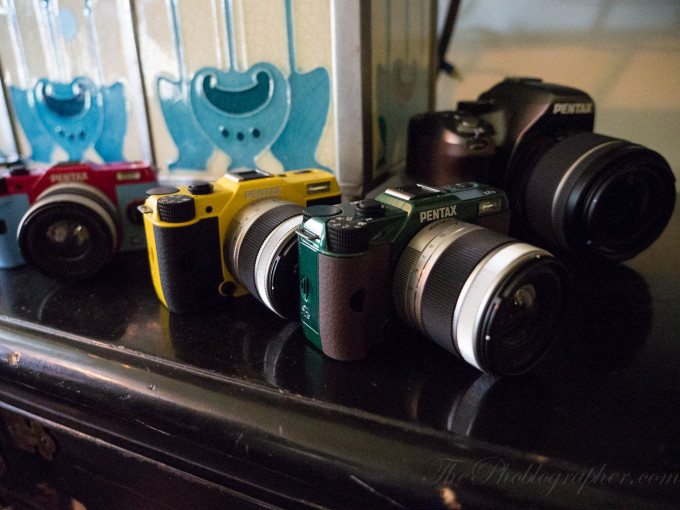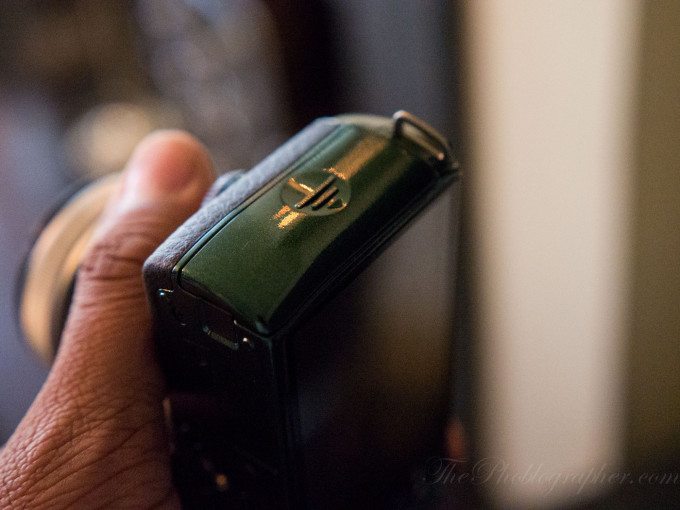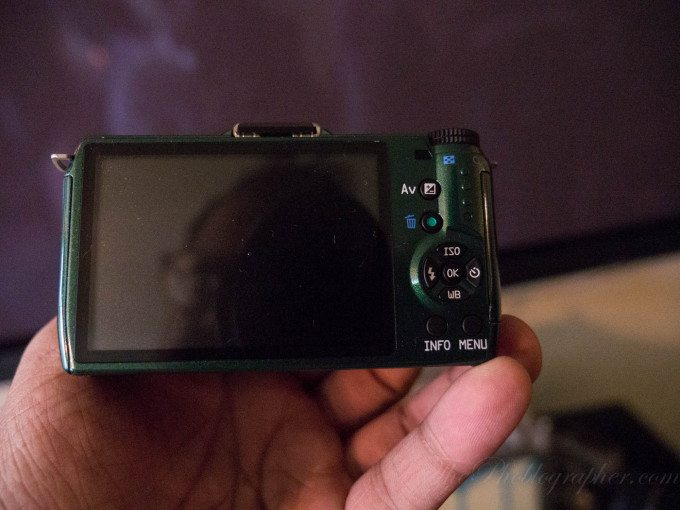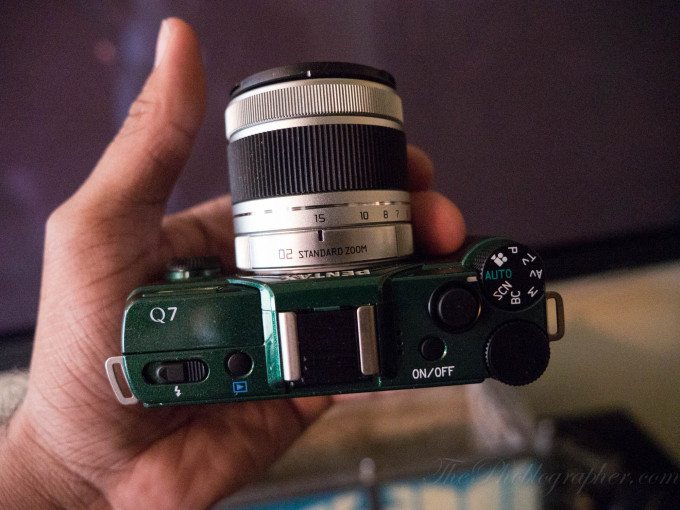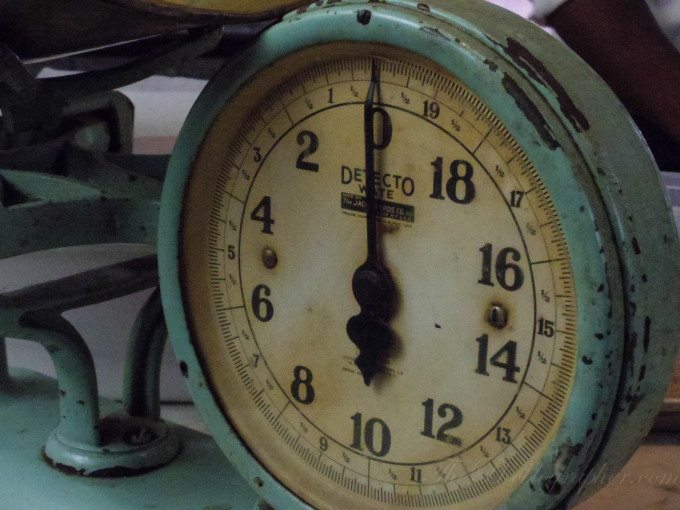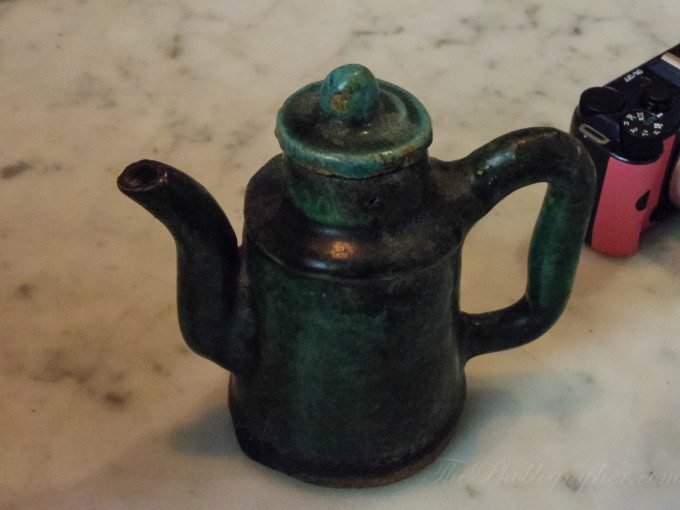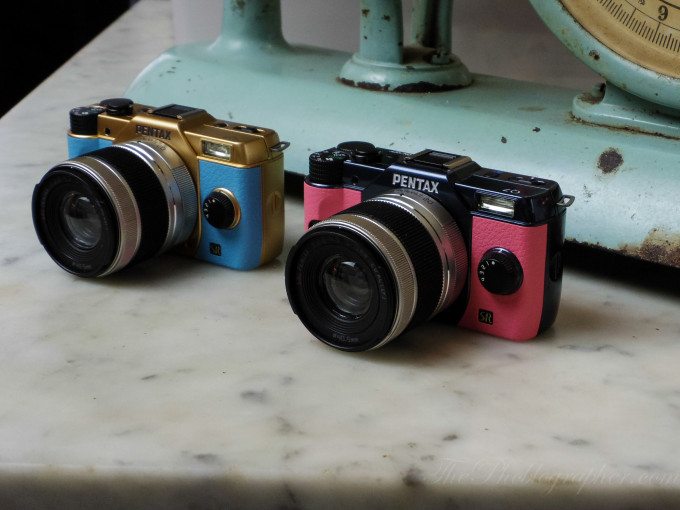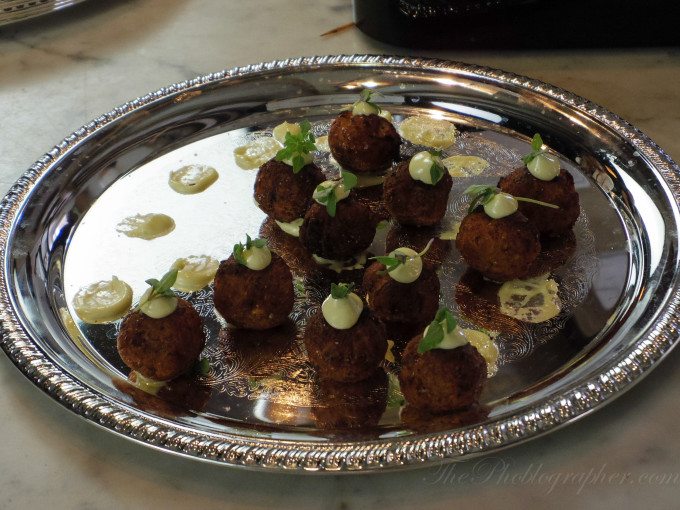The Pentax Q system has often been the butt of many jokes due to their itty bitty size and their even more minuscule sensor–even though it has gotten bigger. Today, Pentax is announcing the latest addition to their Q line with the Q7–and also stated in a press conference with us that they’re still very fully committed to the Q system. Though I’ve never personally reviewed a Pentax Q, I have to admit that they’re fun and perhaps the digital equivalent to a toy camera.
The Q system cameras are also quite well built and in many ways look like the company’s old Auto110 cameras for 110 film.
But we really have to emphasize that the cameras aren’t for everyone after playing with the pre-production unit that we handed today.
Tech Specs
SENSOR
Type: 1/1.7” Backlit CMOS w/ primary color filter
Effective pixels: 12.4MP
Total pixels: 12.76MP
Recorded Resolutions (Pixels)
Still: JPEG
[4:3]L:12M(4000×3000),M:7M(3072×2304),S:3M(1920×1440)
[3:2]L:10M(4000×2664),M:6M(3072×2048),S:2M(1920×1280)
[16:9]L:9M(4000×2248),M:5M(3072×1728),S:2M(1920×1080)
[1:1]L:9M(2992×2992),M:5M(2304×2304),2M(1440×1440)
RAW: [4:3]12M(4000×3000)
Quality Levels: RAW (12bit): DNG, JPEG: ★★★ (Best), ★★ (Better), ★ (Good)
RAW and JPEG simultaneously recordable
LCD MONITOR:
Type: 3.0-inch TFT color LCD monitor, wide angle viewing, AR coating
LCD resolution: 460,000 dots
Adjustable: Brightness and Color
Field of View: approx. 100%,
Display info: Grid display (4×4 Grid, Golden Section, Scale display),
Bright/dark area warning, Histogram
FOCUS SYSTEM
Type: Contrast detection AF
Autofocus Method: Face Detection, Tracking, AF Select (25 Points), Select, Spot
Focus Method: AF / MF Switching
Brightness Range: EV0 to 18(ISO100)
AF Assist Light: Dedicated LED Lamp
Manual Focus Assist: OFF/x2/x4
Focus Peaking: Yes
LENS MOUNT
Type: PENTAX bayonet Q-mount
Usable lenses: Q-mount lenses, K-mount lenses (w/ Adapter Q for K Lens).
FLASH
Type: Built-in retractable P-TTL flash
Guide number: approx. 4.9 (ISO100/m) / approx. 7 (ISO200/m)
Angle of view: coverage: wide angle-lens, equivalent to 28mm in 35mm format
Flash modes: P-TTL, Red-eye Reduction, Slow-speed Sync, Trailing Curtain Sync
Sync Speed: Lens shutter: 1/2000 seconds, Electronic shutter: 1/13 seconds
Flash Exposure Compensation: –2.0 to +1.0 EV
STORAGE MEDIA
Removable memory: SD, SDHC, SDXC and Eye-Fi Card
INTERFACES
Ports: USB 2.0 (high-speed compatible) / AV output terminal, HDMI output terminal (Type D)
Video out: NTSC, PAL
USB Connection: MSC / PTP
POWER SUPPLY
Power source: Rechargeable Lithium-ion Battery D-LI68
Number of recordable images: approx. 250 images (with 50% flash usage), approx. 260 images (without flash usage)
Playback time: approx.160 minutes
* Using a new lithium-ion battery at 23 °C, (tested in compliance with CIPA standard).
PHYSICAL SPECIFICATIONS
Dimensions (W x H x D): Approx. 4”(W) x 2.3”(H) x1.32” (D) (exc. Operating parts and protrusions)
Weight:
Without battery or removable memory: approx. 6.35oz (180g)
With battery and memory card: approx. 7oz (200g)
Construction material(s): Reinforced polycarbonate plastic
Operating temperature: 32-104°F
KIT COMPONENTS
USB Cable I-USB7, Strap O-ST131, Rechargeable Lithium-ion Battery D-LI68,
Battery Charger D-BC68P, Software (CDROM) S-SW133
(Hot shoe cover FK, Body mount cover (both mounted on camera))
Software: SILKYPIX Developer Studio 3.0 LE for PENTAX)
FILE STORAGE MATRIX (BASED ON 4GB MEMORY, 4:3 ASPECT RATIO)
| STILL |
RAW |
««« |
«« |
« |
| 12M |
182 |
807 |
1122 |
1889 |
| 9M (16:9) |
1071 |
1485 |
2485 |
|
| 7M |
1351 |
1869 |
3108 |
|
| VIDEO (30 FPS) |
1920×1080 |
1280×720 |
640×480 |
|
|
00:39’54 |
01:23’43 |
03:21’55 |
*The maximum length for a movie is 25 minutes, in addition, recording may stop if internal camera temperature becomes too high.
IMAGE STABILIZATION
Still: Sensor shift Shake Reduction
METERING SYSTEM
Type: TTL image sensor metering, segment metering, center-weighted metering, spot metering
Exposure compensation: EV1 – 17 (ISO 100, F1.9 lens), +2EV using the Electronic Shutter setting or using the built-in ND filter
ISO SENSITIVITY
AUTO: ISO 100 to 12800 (1/3 EV steps)
Bulb mode: up to ISO 1600
SHUTTER
Type: Lens shutter: 1/2000 – 30 seconds
(1/3EV step, 1/8000 – 30 seconds when Electronic Shutter setting is enabled), Bulb
*Shooting at 1/8000 – 2 seconds with Electronic Shutter and Bulb shooting are not available when using a lens that has no lens shutter.
HDR Capture: Auto, HDR 1, HDR 2
Multi-Exposure: Number of shots: 2-9, Exposure adjusted automatically.
Dynamic Range Adjustment: Highlight and/or Shadow correction
Interval Shooting: Shooting interval: 3 sec. to 24 hr., Start Interval setting: immediately from the
set time. Number of shots: up to 999 images
Green simplified mode available: no
Face detection available: Yes
DRIVE MODES
Single frame, Continuous (Hi, Lo), Self-timer (12s, 2s), Remote Control (0 sec., 3 sec., continuous), Exposure Bracketing (3 frames, remote control), Multi-exposure (0 sec., Self-time, remote control), Interval Shooting
Continuous Shooting: Approx. 5 fps, JPEG (12M / ★★★ / Continuous Hi): up to 5 frames,
Approx. 1.5 fps, JPEG (12M / ★★★ / Continuous Lo): up to 100 frames
Self-timer: Yes (12 sec, 2 sec)
Remote control: Yes (Instant, 3 sec. Delay, Continuous)
EV Compensation: ± 3EV (1/3EV step)
AE Lock: Can be assigned to the green/delete button from the menu.
Continuous as long as the shutter release button is pressed halfway.
PLAYBACK MODES
Playback View: Single frame, multi-image display (4, 9, 30, 56 segments), display magnification (up to 16x, scrolling and quick magnification available), rotating, histogram (Y histogram, RGB histogram), bright/dark area warning, detailed information, folder display, date display, slideshow.
Digital Filters: Base Parameter Adjustment, Toy Camera, High Contrast, Shading, Tone Expansion, Invert Color, Extract Color, Unicolor Bold, Water Color, Posterization, Slim, Fish-eye, Retro, Soft, Sketch Filter, Miniature, Soft, Starburst
RAW Development: File Format (JPEG), Aspect Ratio, Color Space, Custom Image, White Balance, Sensitivity, High-ISO NR, Shadow Correction, Distortion Correction.
Edit: Resize, Cropping (aspect ratio adjustment available), Index, Movie Editing (divide or delete selected frames), Capturing a JPEG still picture from a movie, Red-eye Edit, Saving buffer as a RAW file
MOVIE
File Format: MOV MPEG–4 AVC/H.264 (.mov)
Recorded Pixels: FullHD(1920×1080,16:9,30fps/25fps/24fps), HD(1280×720,16:9,30fps/25fps/24fps), VGA(640×480,4:3,30fps/25fps/24fps)
Sound: Built-in monaural microphone
Interval Movie: Recording interval: 3 sec., 5 sec., 10 sec., 30 sec., 1 min., 5 min., 10 min., 30 min., 1 hr.,
Recording time: 12 sec. to 99 hr.
Start Interval setting: immediately, from the set time
FILE FORMATS
Still: RAW (DNG), JPEG (Exif 2.3), DCF2.0 compliant
Movie: MOV MPEG–4 AVC/H.264 (.mov)
CUSTOMIZATION
Custom Functions: 16
Mode Memory: 10 items
Button/Dial Customization: Green/Delete button: Green Button, Preview, One Push File Format, AE Lock, Enable AF
Quick Dial: Smart Effect, Custom Image, Digital Filter, Aspect Ratio
Ergonomics
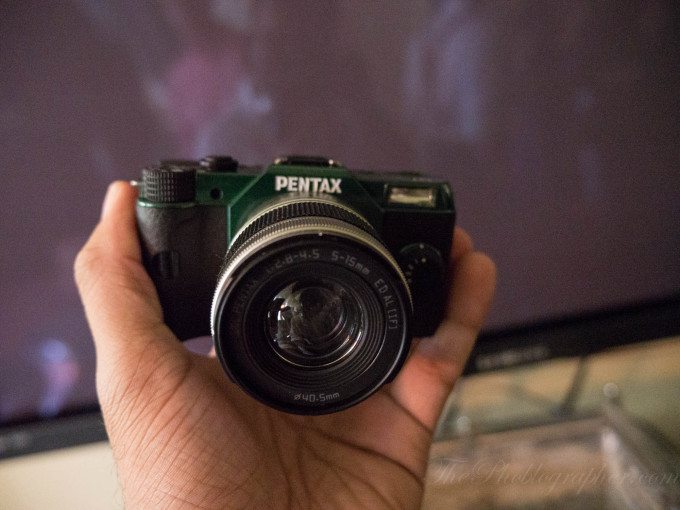
The Pentax Q7 is surely the smallest interchangeable lens camera that we’ve ever held and when you put it in your hand, you start to realize more than ever that the camera was built for small prime lenses and not zooms at all. However, the Q7 has a couple of controls on the front such as a dial with four different positions.
The side of the camera has an obvious SD card port, although its a bit tough to get your card both in and out of there.
The back of the Q7 is characterized by a large LCD screen and many buttons that will be familiar to Pentax users–including the green auto-exposure button. One of the more odd choices though is the placement of the AV button–which can make manual shooting quite difficult to do.
That manual shooting can be difficult due to the fact that the exposure dial is right on top of it on the top of the camera. In front of that is the mode dial while next to that is the shutter release. Then there are all the normal things such as the pop-up flash, hot shoe port, playback button and the light to signal that the camera is on/off.
Build Quality
In many ways, we want to liken the Pentax Q7 to a point and shoot camera. And for what it is worth, it’s got some solid build quality to it.
Ease of Use
We feel that the Pentax Q should be kept on auto and never touched or at least set to Aperture mode and locked in there. Despite this, the menus are simple to navigate but the ergonomic layout just wasn’t tickling our fancy.
Autofocus
The autofocus of the Pentax Q7 should be likened to that of most point and shoots–and not the premium ones like the Fujifilm X100s. Because there is such a small sensor in the camera, most things will be in focus anyway.
Image Quality
Sorry Pentax fans, but we really need to be honest here. We weren’t thrilled by the image quality from the Q7. Sure, it has a small sensor but the back LCD screen made us believe that the images we were getting were much sharper and more vibrant. But upon importing them into Lightroom 5, we were a bit disappointed.
However, someone that is looking for a point and shoot with more versatility would probably be alright with the output.
First Impressions
Although more of my time today was spent working with the Pentax K-50 and K-500, I still was able to get enough of an experience with the Pentax Q to figure out that this is a camera that really isn’t for everyone. Many press members at the event hooked it up to a Pocket Wizard and shot models with it, but I’m not sure that I would do that. When doing that, you lose most of the advantages of a point and shoot–such as a leaf shutter.
We’ll be happy to give the Q7 a second chance later on, but we just couldn’t warm up to it.
Please Support The Phoblographer
We love to bring you guys the latest and greatest news and gear related stuff. However, we can’t keep doing that unless we have your continued support. If you would like to purchase any of the items mentioned, please do so by clicking our links first and then purchasing the items as we then get a small portion of the sale to help run the website.


